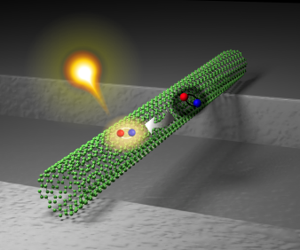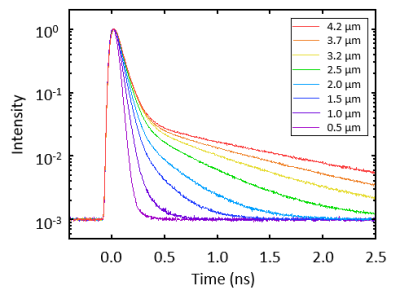Research:High efficiency dark-to-bright exciton conversion in carbon nanotubes
Atomically thin semiconductors, such as transition-metal dichalcogenides and carbon nanotubes, offer new opportunities for developing nanoscale photonic and optoelectronic devices. The optical processes in these materials are governed by tightly bound electron-hole pairs, or excitons. Interestingly, unexpected optical phenomena can arise from dark states of the excitons, where optical transition is forbidden by the selection rules. Despite their importance, the dark excitons lack spectral signatures and generally their contribution to emission intensity is insignificant. Here, we report that a considerable fraction of light emission can originate from the dark excitons in carbon nanotubes.

We use time-resolved photoluminescence measurements to study decay dynamics and diffusion properties of excitons, and we systematically investigate how nanotube structure impacts intrinsic lifetimes and diffusion coefficients for both bright and dark excitons as well as state transition rates. In long nanotubes, we find that the dark-to-bright transition rates can be considerably high, and that more than half of the dark excitons can be transformed into the bright excitons. Adsorbed air molecules on the surface of the nanotubes also significantly enhance the transition rate.

Our findings show the nontrivial significance of the dark excitons on the emission kinetics in low-dimensional materials and demonstrate the potential for engineering the dark-to-bright conversion process by using surface interactions. Manipulation of multiple exciton species could lead to the development of advanced devices with devoted channels for exciton transport, recombination, and dissociation.
To learn more about this work, please refer to:
High efficiency dark-to-bright exciton conversion in carbon nanotubes
Phys. Rev. X
9, 041048 (2019).
![]()
RIKEN Research Highlight:
"Dark excitons can make a high contribution to light emission from nanotubes"
(Included in
RIKEN Research, Summer 2022
![]() )
)